BR period rolling stock
BR wagons and some ex-LNER and ex-LMS. This will build up as I dig out more pictures...
All the photographs are mine except where stated.
Divided into three sections:
1 - Goods brake van 2 - Other goods 3 - BR Mk.1 coaches
1 - BR goods brake vans
I did an article in Model Rail about building the BR Standard Goods Brake van from a kit with a lot of prototype pictures and how the design developed from the LNER one first introduced in 1929, and how BR gradually introduced detail changes between Diagrams and between Lots inside them, and some mistakes in British Railway Wagons", Don Rowland, 1996. The basic BR Diagrams were:
1/500 - continuation of the LNER design 1/504 - LNER-BR hybrid 1/506 - BR - with more BR developments 1/507 - BR - with more BR developments
It's complicated and I advise getting the back issue for more (Model Rail, Feb 2002, and illustrated letter by myself and David Larkin, Model Rail, Jan 2006). Here are some more pictures:
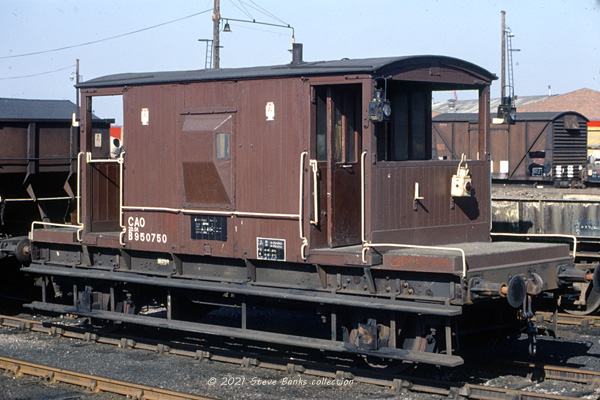
B95070 was built in 1950 at Faverdale to the hybrid Diagram 1/504 and the first lots were manually braked, either plain or, as in this case, with a through vac pipe, and when that was removed, it was TOPS-coded accordingly, CAO. Among the Diagram's features were LNER-style divided handrails and axleguards (for which I used the modellers' term "W-irons").
Seen at Watford Junction on 12th April 1980. Photo: author's collection.
Click on the image for an enlargement

No longer in its prime, No B952405 had been built at Faverdale in 1954 to Diagram 1/506 as a plain unfitted van but as can be seen, was later given a through vac pipe and coded CAP. Vertical handrails are the later, continuous type.
Horwich on 16th August 1980. Photo: author's collection.
Click on the image for an enlargement
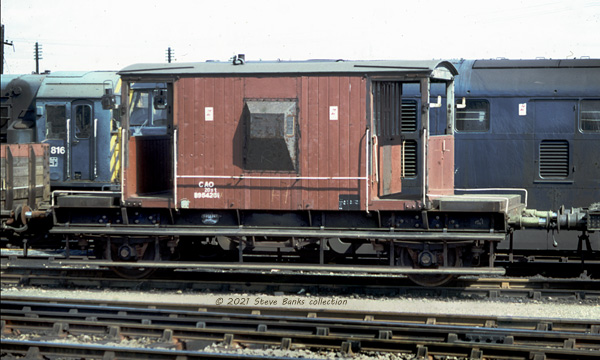
This GBV was also to Diagram 1/506 but built at Faverdale later, in 1958, and with vacuum brake. However, that has been removed and with no through pipe either, the van was coded CAO. Roller bearings have been fitted and Oleo buffers. Paintwork on the wooden body is alright but not on the steel ducket which has rusted quite badly.
Didcot on 18th August 1981. Photo: author's collection.
Click on the image for an enlargement

A fine view in May 1962 of a diagram 1/506 van built in 1954 with manual brake only but subsequently fitted with a through vacuum pipe, number B952521. Note the different axleboxes, quite a common occurrence. Ex-NBR J37 No 64595 of St. Margarets in Edinburgh is shunting what looks like the daily goods pick-up and two coal wagons, which by this time was often the principal traffic. The guard's lamp has yet to be attached. Photo: G. Harrop.
Iain Chalmers of the NBR Study Group has suggested Kirkliston, ten miles west of Edinburgh on the South Queensferry branch and I've added the only available 25" map from the NLS which shows the station before it was closed to passengers in 1933 but stayed open for goods traffic until 1966 when the branch was closed. I suspect that it had become the local railhead for coal.

The station building was wooden and demolished after the passenger service was withdrawn, likewise the signal box to be replaced by a ground frame.
Click on the image for an enlargement
2 - Other goods wagons
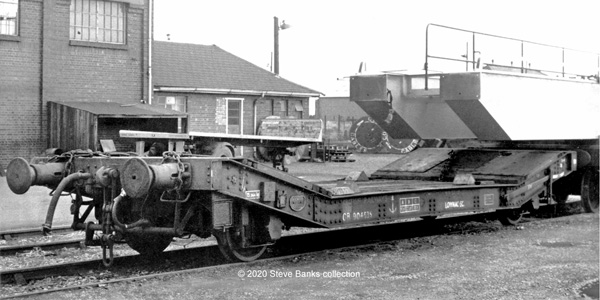
At Banbury in the late 1970s, a BR 25T Lowmac SC, B904535, built 1950 to Diagram 2/242. Fitted with BR standard axleboxes and AVB (the Lowmacs were a mixture of manually braked and fitted designs).
Interesting that the "B" series running number has been prefixed by a "C". It was serving as a match truck under a long load. In the background is part of the GWR-built goods shed. Photo: Author.
Click on the image for an enlargement

The middle of the Lowmac showing details of past and present liveries. Note the "BRITISH RAILWAYS" - remarkable, possibly dating from 1950 when this one was built. The enlargement zooms in on the vehicle - for more of the whole image and the GWR Goods Shed see the Banbury Yards and Freight topic, link below). Photo: Author.
Click on the image for an enlargement
New info
A more exotic life than average?
Here are some British and Continental aspects that I never appreciated before. I should first say that BR produced 14 types of Lowmac and this running number is in Don Rowland's book under BR Diagram 2/242 where it is shown as one of 38 built in 1950 and lettered as Lowmac EP and Lowmac SC, for the ER and SR, respectively. The livery appears to show a mixture of early BR (some of it quite old and grinning through) and TOPS styles when white borders were used.
Mark Hambly has sent some detailed notes on the grounds that this Lowmac had a slightly more exotic life than the average Lowmac SC. He suggests that at some time in this vehicle's life it was fitted out for continental traffic, presumably because of a need to supplement two types which were built for such traffic:
LOWMAC EU (BR Diagram 2/247 - 13 built 1955 "For continental working" LOWMAC SF (BR Diagram 2/254 - 8 built 1955 "For continental working"
There is a number of tell-tale features:

Buffers - continental style with longer housing and hole in the face.
Screw coupling - also of the longer continental style to suit the buffers.
Through air pipe.
Label clip - continental-style (below the frame at the extreme LH end of the wagon.

The anchor - is the symbol for a vehicle built to the British loading gauge and authorised to travel overseas via train ferry.
"British Railways" - wasn't normally used on wagons purely for UK domestic traffic.
However, what is missing is any evidence of the previous presence of a full 12-digit international number. This perhaps suggests that any continental travelling by this vehicle predated introduction of the international numbering scheme in the mid-1960s, prior to which the UK number and "British Railways" would have sufficed, although addition of "G" in front of the number may have been an informal addition to emphasise that the wagon originated from Great Britain.
Also absent are any hooks or eyes on the side for securing the wagon on board the ferry, an almost universal feature of ferry stock, but perhaps the chains visible around the buffer housings at the LH end of the wagon were provided for that purpose and deemed acceptable if the vehicle's international use was only temporary or short-term?
All told, then, an interesting example which raises more questions!

Also seen at Banbury in the late 1970s, an ex-LMS 13T, 3-plank dropside wagon, now in Departmental service, No DM 480619. An unfitted wagon with the manual handbrake applied on this side. Photo: Author.
Click on the image for an enlargement

Ex-LMS 13T, 3-plank dropside wagon, DM 480619, the other side.. Photo: Author.
Click on the image for an enlargement

Ex-LMS 13T, 3-plank dropside wagon, DM 480619 with one side down, revealing what looks like a load of breeze blocks. Photo: Author.
Click on the image for an enlargement
The next two pictures of BR wagons are a bit of a puzzle for they are shown in Don Rowland's book "British Railways Wagons" (1996), as to Diagram 1/040, "13T High sided (5plank and corrugated ends) with Sheet Support Rail, Lettered Shock".
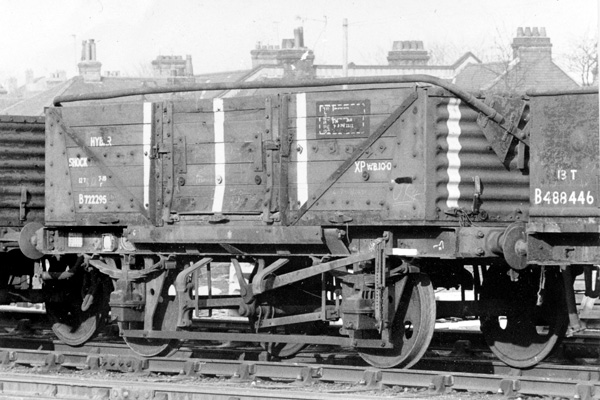
B722295 was Derby-built to Lot 2416 in 1952 and is rated 12T. It also carries what appears to be "HYBAR" and SHOCK" (Bounds Green, c1975). Photo: Author.

Seen on the same day is B723768, built to Lot 2546 in 1955, and also lettered 12T but there is another difference for the sheet rail is absent: it's hard to tell if it had been fitted in the first place, or removed later. There is a mysterious dark area where "HYBAR" or "HIGH-BAR" may have been painted but that's supposition on my part. The general condition is more weary: half the planks have been replaced at various times but the vertical stripes have not been repainted, while those on the corrugated ends have largely flaked off. It's quite a poor sight really. (Bounds Green c1975). Photo: Author.
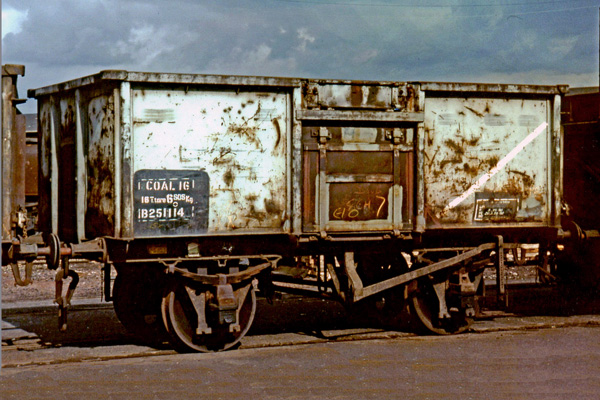
BR 16T mineral wagon No 251114 to Diagram 1/108 lot 2797, seen at Stourton, Leeds, 1975. Note the different axleboxes. Photo: Author.

Where DM 731403 was captured, I cannot say, possibly the Leeds area? There's a clue on the MR/LMS signal box where the word "STATION" can be seen....
The vehicle itself is a former LMS goods brake van that's been relegated to departmental use. The main lettering states RETURN TO NOTTINGHAM PREFAB DEPOT. (1975). Photo: Author.
- Click on the image for a full-size version. Return by clicking the "x".

LNER 21 ton coal hopper wagon. Again the location is unknown, but possibly at Banbury.
This is an example of LNER D.100 built from 1935-48 with detail differences, originally for 20T of coal, subsequently, 21T.
E307745 was one of the last batches, built in 1948 for the LNER by Nelson. Behind it in bauxite livery is B417959, the BR version to D.1/416 with a welded body. Nearest the camera is a BR goods brake van. (1977). Photo: Author.
Click on the image for a full-size version. Return by clicking the "x".
3 - BR Mk.1 coaches
Mk.1 kitchen car

Seen in the sidings by Neasden Station displaying its roof. It's to Dia.700 and tallies with the sketch on p.218 in Keith Parkin's "BR Mk.1 Coaches", Pendragon, 1991. Possibly in an excursion. Note that 3 out of the 5 coaches visible are Gresleys, the one beyond the RK looking like a D.186 3rd Open, possibly another at the edge of the picture. In between is a Mk.1 TSO. May 1959. Photo: B.W.L. Brooksbank


